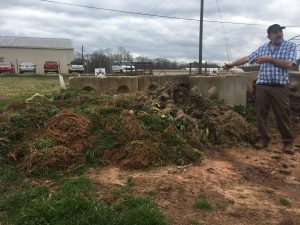Image: Something that surprises me about the facility
What surprises me about the facility was their large-scale composting, and how composting sometimes involves more than just dumping scraps in a spot. Active composters keep the material separated into zones based on how decomposed it is, and sometimes the material has to cycle through another time to be done.
In this picture, I see the UGArden speaker and professor showing the completely plant-based compost area of the garden. When looking at each section from left to right, the compost material gets less and less course, and it decomposes to create rich compost material to aid crops.
One thing that really strikes me in this picture is the drastic change in the size of the piles (going from left to right). It’s surprising how such a large mass of material through decomposition yields so little compost material in the end.
This picture makes me think about how long it truly takes for the plant-based material to fully decompose for composting. I thought it would take at the most two weeks for it to graduate on and on in the different stages, but it usually takes up to months, and for full decomposition, sometimes years. I always thought that it would take around six months at the most to break down, but in this intermediate composting method, it takes much longer.
When I look at this picture, I feel called upon to start composting. I know it would be hard to do it in my dorm room, but by seeing the piles in person, I feel that it’s important that I do my part to not waste scraps and plant material. If I don’t compost, the material will just end up in landfills and be put to no use, so it’s important that I do the right thing to help both crops and the environment.
I think this picture is about the visible process of composting. I had never really seen in up close and in person, as my family doesn’t compost, so the visual was nice. And, his commentary about how they facilitate this process was really educational as well.

